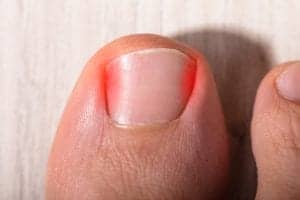
Did you know that our nails are essentially hardened skin cells? They might seem tough as, well, nails, but they can present their own unique health problems if they aren’t treated with care and attention.
What Exactly Are Nails?
We want nails to look strong and healthy, serve as an onboard toolset of sorts and protect our fingers and toes. But what makes up a nail and how a nail grows is amazingly delicate.
Your nails are made up mostly of keratin, which is a protein found in the skin and hair. As nails grow out from the matrix – the hidden half-moon area under the cuticle – older cells in the nail are pushed forward and harden to form a visible nail that protects and supports tissues in our fingers and toes.
Common Nail Issues
Nail problems make up about 10 percent of all dermatological conditions. As we age, nails thicken and become more susceptible to issues such as fungal and bacterial infections. Often these are nothing to worry about, but some may signal disease. Here are some common nail issues:
- White Spots – Typically white spots in the nail are caused by mild trauma such as catching a finger in a door. Typically, the nail will grow out and the white spots will disappear. However, if you see several white spots that do not seem to grow out, those might be an indication of an infection or other medical condition that may need treatment.
- Ingrown Nail – Most of us have had ingrown nails when the corner of the nail curves into the skin. Ingrown nails can be painful and sometimes get infected.
- Bacterial Infections – Redness, swelling and pain of the skin around the nails can be signs of a bacterial infection. Sometimes the nail may appear green. If you have your hands in water or the skin around the nails is exposed to chemicals on a regular basis, you might be susceptible to developing a bacterial infection.
- Nail fungus – This is a common condition that typically begins as a white or yellow spot under the tip of the nail. The nail may become discolored, thickened, misshaped and maybe even painful. If you see any of these symptoms, make an appointment with your Water’s Edge dermatologist.
- Dark Spots – If dark spots or streaks appear on any nail and you know it’s not because of an injury, see your practitioner. Dark spots or streaks on a nail could be signs of melanoma – the deadliest form of skin cancer. Be sure to get checked out right away.
Tips to Keep Nails Healthy
Practicing good nail habits is key to keeping them healthy. Water’s Edge recommends these tips:
- Keep nails clean and dry to help prevent bacteria, viruses or fungus from collecting under the nail.
- Cut nails straight across, rounding them slightly at the tips for maximum strength.
- Keep nails shaped and free of snags.
- Avoid biting fingernails and do not remove the cuticle.
- Trim toenails regularly to keep them short.
- Soak your feet in warm salt water for 5 to 10 minutes if toenails are thick and difficult to cut. This softens the nails and makes them easier to trim.
- Avoid digging out ingrown toenails, especially if they are infected or sore. See your practitioner for treatment.
- Wear shoes that fit correctly and alternate your shoes so you are not wearing the same shoes every day.
- If you see changes in your nails, such as swelling or pain, see your Water’s Edge provider.
- If you have diabetes or poor circulation, watch your nails carefully. See your Water’s Edge provider at the first sign of a problem.
Your nails can reveal a lot about your health, and changes in nails can signal disease or a medical issue. If you notice any issues or changes in your nails, call Water’s Edge to make an appointment with your provider: 877-544-3880.





